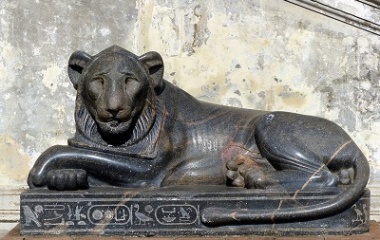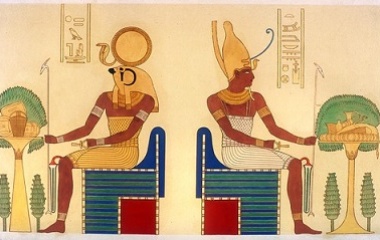Who Is Atum?
Atum, also known as the great he-she, was the solar creator god of ancient Egypt. Self-created from Nu, the primordial waters, he embodied the essence and the capabilities of both sexes. The name Atum is derived from the word tem meaning complete – quite suitable, since he was able to create the first divine couple through masturbation. He made the goddess Tefnut and the god Shu this way, and they are the ancestors of all the other gods.
As the most ancient deity of Egypt, he was the first god in the Ennead of Heliopolis, the collection of nine deities, and although Heliopolis was the main cult center, he was worshipped throughout the land. Many pharaohs claimed to be descended from Atum so he is most often depicted wearing the crown of a king.
He features prominently in the religious inscriptions of ancient Egypt known as the Pyramid Texts which were carved on the walls of the pyramids during the period of the Old Kingdom.
Origin
At first there was nothing – just primordial water called Nu. A small hill of earth emerged from the water, and Atum created himself from it. The myths tell that he masturbated and then spit the god Shu and the goddess Tefnut from his mouth. The story explains his completeness as a creator, as well as the nickname the great he-she. Having both male and female qualities, he was able to create children without a female partner.
He was the first and most important god of the Ennead, although in later kingdoms, as the religion evolved, his name and qualities were combined with other gods: Atum-Ra, the sun god; Atum Khepri, the rising sun god; and Atum Horus, solar god and god of monarchs. Eventually, his prefix name was dropped, and each of the deities had their own name and identity. Atum was then considered the embodiment of all of them, and the father of the pharaohs.
The process of absorbing gods into one another and combining beliefs is called syncretism, and is an integral part of the Egyptian religion as it evolved through the kingdoms. Combining gods and worshipping them in different ways allowed polytheism to progress and remain over a long period of time under the rule of various pharaohs. Many of the pharaohs were titled “Son of Atum”, and he is represented in the rituals of the cults and especially during coronation ceremonies of the pharaohs.
The derivation of his name, the word tem, meaning complete or finisher, is an indicator of his completeness as a bisexual god and also of his ability to finish the creation of the world.
Family of Atum
After he created his children, the goddess of moisture, Tefnut, and the god of air, Shu, they themselves produced the next pair of gods: Geb, god of the earth, and Nut, goddess of the Sky. Geb and Nut then provided Atum with his great-grandchildren, namely Osiris, Isis, Set, Nephthys and Horus, completing the Ennead of Heliopolis.
Symbolic Influence
Atum was considered a sun god, which explains his affiliations with later gods. Ra was considered the primary sun god, Khepri was associated with the midday sun and Horus was a god of many titles, including the god of the east and the god of the rising and setting sun.
The first symbol used to represent Atum was a serpent, since he came from the water. But later depictions are more relevant to his association as the father of the pharaohs, and he wears a head cloth or a red crown similar to that of a king. The way to distinguish Atum from a pharaoh is by the shape of his beard. Occasionally, he appears in the form of another animal, symbolizing the end of the creative cycle when the animals were also given life.
Modern Influence
The remains of the ancient city of Heliopolis, the city of the sun, is located north of Cairo. The 120-ton obelisk of the Temple of Re-Atum still stands. The Egyptian name for obelisk is luna, which means pillar, and the city was once known as the city of the pillars. Luna were designed to catch the rays of the sun at dawn, representing the creation of Atum and the world from the original mound emerging from the waters.
Since this location was considered the place of the origins of creation, it became the main learning center in Egypt and priests congregated in Heliopolis to study religious history and philosophy.
The great Greek philosopher Plato, who may never have been to Egypt, used an image of the sun to represent the idea of a single god and creator of existence. A basic concept in the modern religions of today, the belief in one god that created the universe from a central place may have originated with the story of Atum, and the story of Ptah, his ancient competition, the creator god of Memphis.











Great
Great😈😈😈Creation…